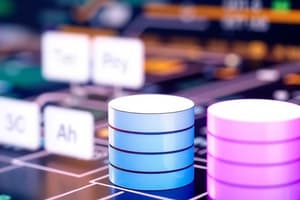Podcast
Questions and Answers
Data Modeling Using the Entity-Relationship (ER) Model 21 October 2019 Lecture 4 Dr. Ahmed Alnasheri Dr. Ahmed Alnasheri Objectives Understand concepts of data modeling and its purpose Understanding the database design process Introduce the major components of ER diagram Learn how relationships between entities are defined Learn how ERD components affect database design and implementation Learn how to interpret the modeling symbols Dr. Ahmed Alnasheri 2 Data Model Model: an abstraction of a real-world object or event – Useful in understanding complexities of the realworld environment Data model – A diagram that displays a set of tables and the relationships between them – Next Slide: “Restaurant” Access data model using Entity Relationship Diagram (ERD) Dr. Ahmed Alnasheri 3 Access Data Model using ERD Dr. Ahmed Alnasheri 4 What is ER Model. And Why. ER is modeling tool used to depict graphically a database design before it is actually implemented. ER Model is used.
Match the following relational model terminology with their definitions:
Match the following relational model terminology with their definitions:
Relation = A table with columns and rows Attribute = A named column of a relation Cardinality = The number of tuples in a relation Domain = The set of allowable values for an attribute
Match the following characteristics of a relation with their definitions:
Match the following characteristics of a relation with their definitions:
Each cell of relation contains exactly one atomic value = Each entry in the table holds a single value Values of an attribute are all from the same domain = All values in a column belong to the same set of allowable values Each tuple is distinct; there are no duplicate tuples = No two rows are identical Order of attributes has no significance = The sequence of columns does not affect the data
Match the following relational database concepts with their descriptions:
Match the following relational database concepts with their descriptions:
Match the following relational database rules with their definitions:
Match the following relational database rules with their definitions:
Match the following relational model terminology with their constraints:
Match the following relational model terminology with their constraints:




